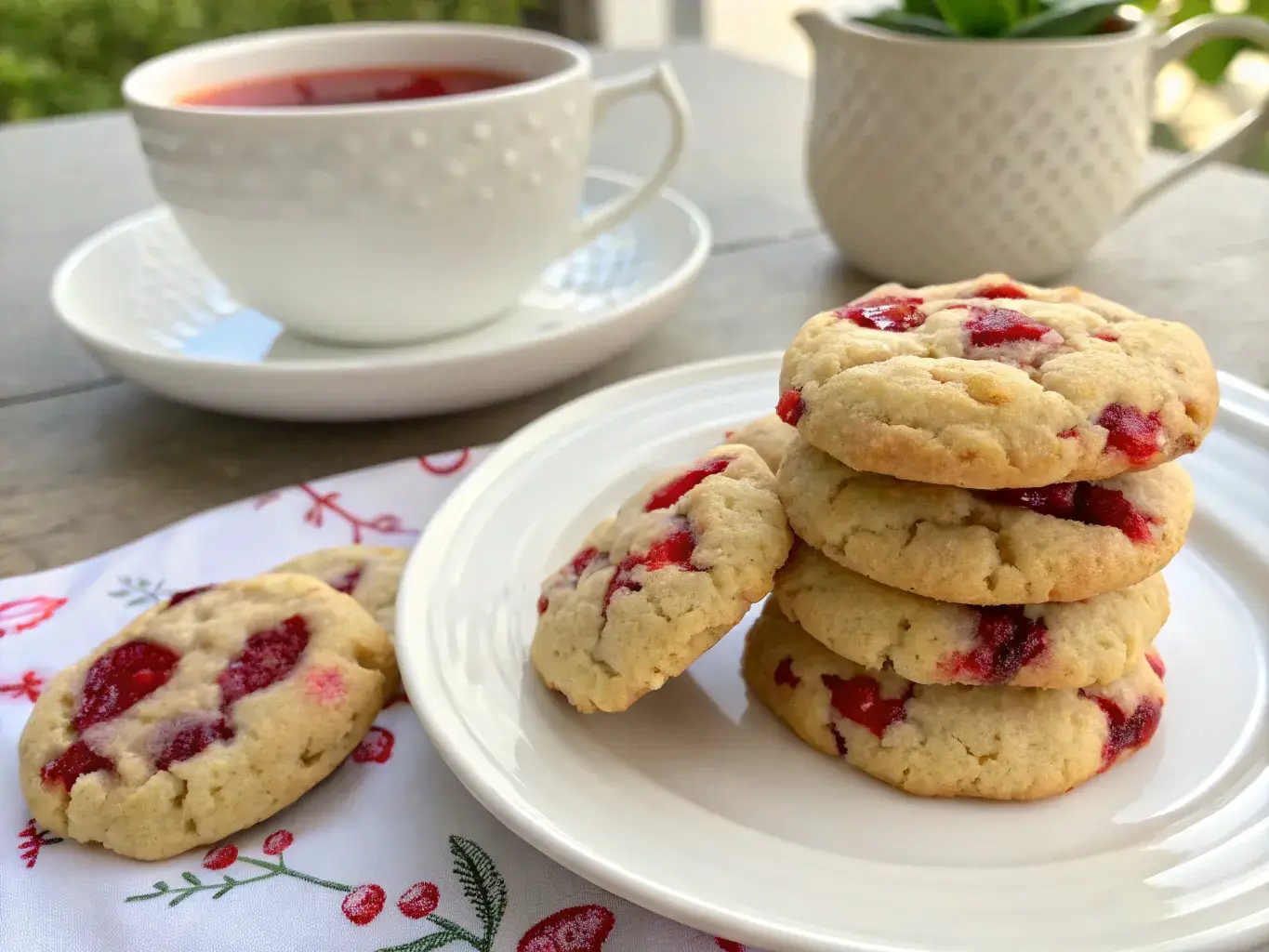Hibiscus cookies have become one of my favorite gluten-free creations here at Recipes of Kitchen, The Gluten-Free Sweet Kitchen. I’m Lidia Bellacci, and my journey into gluten-free baking began after being diagnosed with gluten sensitivity. What started as a challenge soon turned into a passion for creating desserts that are both beautiful and safe to enjoy.
These hibiscus cookies perfectly reflect that mission. With their vibrant pink color, tart yet floral flavor, and wholesome ingredients, they’re a treat that brings joy to every bite.
Introduction to Hibiscus Cookies
What Are Hibiscus Cookies
Hibiscus cookies are tender, flavorful treats made with hibiscus petals, hibiscus tea, or hibiscus powder. They’re known for their gorgeous reddish-pink hue and a taste that’s both sweet and slightly tart, similar to a mix of cranberry and raspberry with a touch of floral elegance. Unlike ordinary cookies, hibiscus cookies bring a refreshing twist that makes them stand out at any table.
Why Hibiscus is Becoming a Popular Baking Ingredient
Hibiscus has gained popularity in baking because it offers so much more than just taste. Its bold natural color eliminates the need for artificial dyes, its tartness pairs well with a variety of flavors, and it’s packed with antioxidants that make it a healthier choice. From home bakers to professional pastry chefs, many are embracing hibiscus as the star ingredient in cookies, cakes, and even breads. It’s a way to bake something that’s not only delicious but also visually stunning and full of character.
Print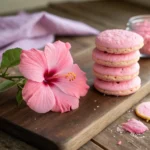
Hibiscus Cookies – A Flavorful and Unique Treat You’ll Love
- Total Time: 32 minutes
- Yield: 24 cookies 1x
- Diet: Vegetarian
Description
Delicate hibiscus cookies with a subtle floral and tart flavor, perfectly crisp on the edges and tender in the center—ideal for tea time or gifting.
Ingredients
1 cup unsalted butter, softened
3/4 cup powdered sugar
1 large egg yolk
1 tsp vanilla extract
2 cups all-purpose flour
1/4 cup dried hibiscus petals, finely ground
1/4 tsp salt
Optional: zest of 1 lemon or orange for added brightness
Powdered sugar for dusting
Instructions
1. Preheat oven to 350°F (175°C) and line a baking sheet with parchment paper.
2. Using a food processor or spice grinder, grind dried hibiscus petals into a fine powder.
3. In a large bowl, cream butter and powdered sugar until light and fluffy.
4. Mix in egg yolk and vanilla extract.
5. In a separate bowl, whisk together flour, hibiscus powder, salt, and citrus zest if using.
6. Gradually add dry ingredients to the wet mixture, mixing until a dough forms.
7. Roll dough into a log, wrap in plastic wrap, and chill for at least 30 minutes.
8. Slice dough into 1/4-inch rounds and place on the baking sheet.
9. Bake for 10–12 minutes, or until edges are lightly golden.
10. Cool completely, then dust with powdered sugar before serving.
Notes
Finely grinding the hibiscus ensures even flavor and color.
For a glaze, mix powdered sugar with hibiscus tea concentrate and drizzle over cooled cookies.
These cookies pair wonderfully with tea or light fruit desserts.
Store in an airtight container at room temperature for up to 5 days.
- Prep Time: 20 minutes
- Cook Time: 12 minutes
- Category: Dessert
- Method: Baking
- Cuisine: Fusion
Nutrition
- Serving Size: 1 cookie
- Calories: 120
- Sugar: 6g
- Sodium: 55mg
- Fat: 7g
- Saturated Fat: 4g
- Unsaturated Fat: 2g
- Trans Fat: 0g
- Carbohydrates: 13g
- Fiber: 0g
- Protein: 2g
- Cholesterol: 20mg
Keywords: hibiscus cookies, floral cookies, tea cookies, edible flowers dessert
Understanding Hibiscus as an Ingredient
Origin and History of Hibiscus in Culinary Traditions
Hibiscus has been cherished in kitchens around the world for centuries. In Mexico and Central America, dried hibiscus flowers, often called Jamaica, are brewed into a refreshing tart tea. In Africa, hibiscus tea, known as bissap, is a cultural staple, while in the Middle East it is used in both drinks and sweets. Over time, bakers began to recognize its versatility, incorporating hibiscus into cookies, cakes, and syrups. Its unique balance of tangy and floral notes made it an ideal ingredient for creative desserts.
Hibiscus in Baking: Dried vs. Powder vs. Syrup
When it comes to baking hibiscus cookies, there are several ways to include hibiscus, each offering slightly different results:
- Dried Hibiscus Petals: Finely ground or steeped, they provide natural color and flavor without added sweetness.
- Hibiscus Powder: Convenient and concentrated, perfect for achieving consistent flavor and color in cookie dough.
- Hibiscus Syrup: Adds sweetness along with floral tartness, ideal for glazes or fillings.
Most home bakers prefer hibiscus powder for cookies because it blends easily into the dough and delivers a vivid hue without extra liquid.
| Hibiscus Form | Best Use in Cookies | Flavor Impact |
|---|---|---|
| Dried Petals | Ground into flour mix | Mild tartness |
| Hibiscus Powder | Mixed directly into dough | Bold, vibrant |
| Hibiscus Syrup | Used in glazes or fillings | Sweet and tangy |
Nutritional Benefits of Hibiscus
Beyond taste, hibiscus is loaded with health benefits that make it a standout ingredient in gluten-free baking. It is rich in antioxidants, which help fight inflammation, and contains vitamin C that supports immune health. Hibiscus also has natural compounds that may help regulate blood pressure. So when you enjoy hibiscus cookies, you’re not only treating yourself to a delicious dessert but also adding a touch of wellness to your diet.
Beyond taste, hibiscus is loaded with health benefits. It’s rich in antioxidants and vitamin C, which support immune health. According to Healthline, hibiscus may also help regulate blood pressure and promote heart health, making hibiscus cookies not just a treat but also a functional dessert.
What Does Hibiscus Taste Like
Hibiscus Flavor Profile Explained
Hibiscus cookies are loved not only for their vibrant color but also for their distinctive taste. The flavor of hibiscus is often described as tart, fruity, and slightly floral, similar to a blend of cranberry and pomegranate with a delicate floral touch. This makes hibiscus cookies refreshing, light, and different from ordinary cookies. The tartness adds a pleasant contrast to the sweetness of cookie dough, creating a balanced treat that delights the palate.
Comparing Hibiscus to Other Floral Ingredients
When compared to other floral ingredients, hibiscus stands out. Lavender cookies, for instance, offer a more subtle, perfumed flavor, while rose-based desserts tend to be sweeter and softer. Hibiscus cookies, on the other hand, deliver a bolder flavor that’s both fruity and tangy. This makes them perfect for those who enjoy desserts with a little zing rather than purely floral notes.
| Ingredient | Flavor Profile | Best Use in Baking |
|---|---|---|
| Hibiscus | Tart, fruity, floral | Cookies, cakes, glazes |
| Lavender | Light, aromatic, floral | Shortbread, tea cookies |
| Rose | Sweet, perfumed, delicate | Cakes, buttercream, candies |
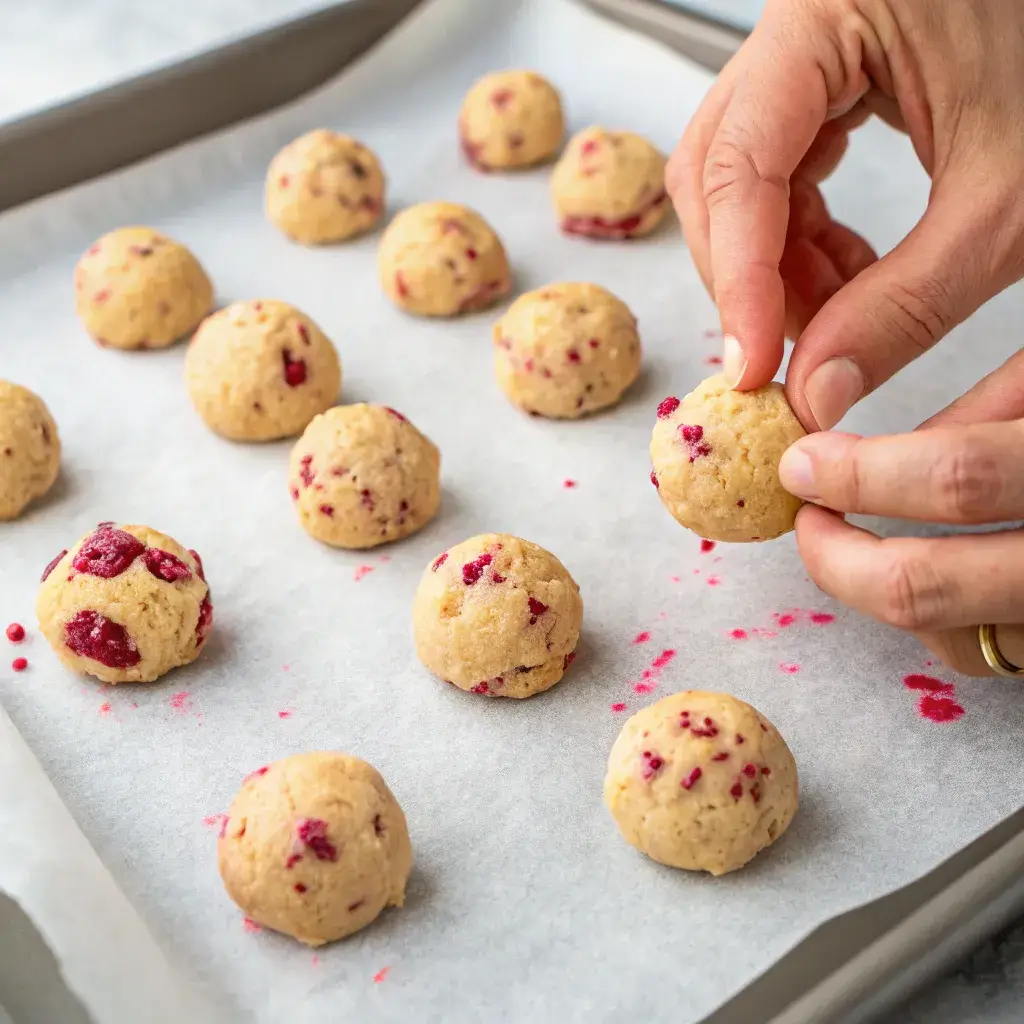
Popular Uses of Hibiscus in Drinks and Desserts
Hibiscus has long been a favorite in beverages, particularly hibiscus tea, known for its deep red color and refreshing taste. But beyond tea, hibiscus is making its way into desserts like sorbets, cheesecakes, and, of course, hibiscus cookies. Hibiscus powder is often used by bakers to give frostings and fillings a naturally vibrant hue without artificial dyes. Its versatility means you can experiment with hibiscus in cookies, macarons, or even bread for a creative and health-conscious twist.
When you bake hibiscus cookies, you bring together the rich history of hibiscus tea traditions with the joy of modern gluten-free baking. The result is a dessert that’s flavorful, colorful, and sure to impress.
What Not to Mix with Hibiscus in Cookies
Ingredients That Overpower Hibiscus Flavor
When baking hibiscus cookies, it’s important to avoid ingredients that dominate the tart and floral notes of hibiscus. Strong flavors like dark chocolate, peppermint, or intense coffee can easily mask hibiscus instead of complementing it. While these ingredients are delicious in other desserts, they compete with the delicate fruitiness of hibiscus rather than enhancing it.
Common Mistakes When Baking with Hibiscus
A common mistake many bakers make is using too much hibiscus at once. While hibiscus cookies should have a vibrant flavor, adding an excessive amount of hibiscus powder or syrup can make the cookies overly tart and even bitter. Another error is combining hibiscus with artificial red dyes, which not only takes away from the natural beauty of the cookie but may also alter the flavor.
Best Practices for Maintaining Flavor Balance
To make perfect hibiscus cookies, balance is key. Pair hibiscus with mild, complementary flavors instead of bold, overpowering ones. Use hibiscus powder sparingly at first, and taste the dough before adding more. If you want to intensify the color without overwhelming the taste, consider blending dried petals into the dough or using a hibiscus glaze after baking.
| Mistake | Effect on Cookies | Better Approach |
|---|---|---|
| Too much hibiscus powder | Overly tart and bitter flavor | Start small and adjust |
| Adding artificial food dye | Alters flavor and appearance | Use natural hibiscus color |
| Mixing with strong flavors | Masks hibiscus profile | Pair with mild, fruity notes |
Pairing Hibiscus with Complementary Flavors
Fruits That Pair Well with Hibiscus
Hibiscus cookies shine when paired with fruits that match their tart and fruity essence. Citrus fruits like orange, lime, and lemon are excellent companions because they enhance the brightness of hibiscus. Berries such as blueberries, raspberries, and strawberries also make delicious additions, giving hibiscus cookies a deeper fruity dimension.
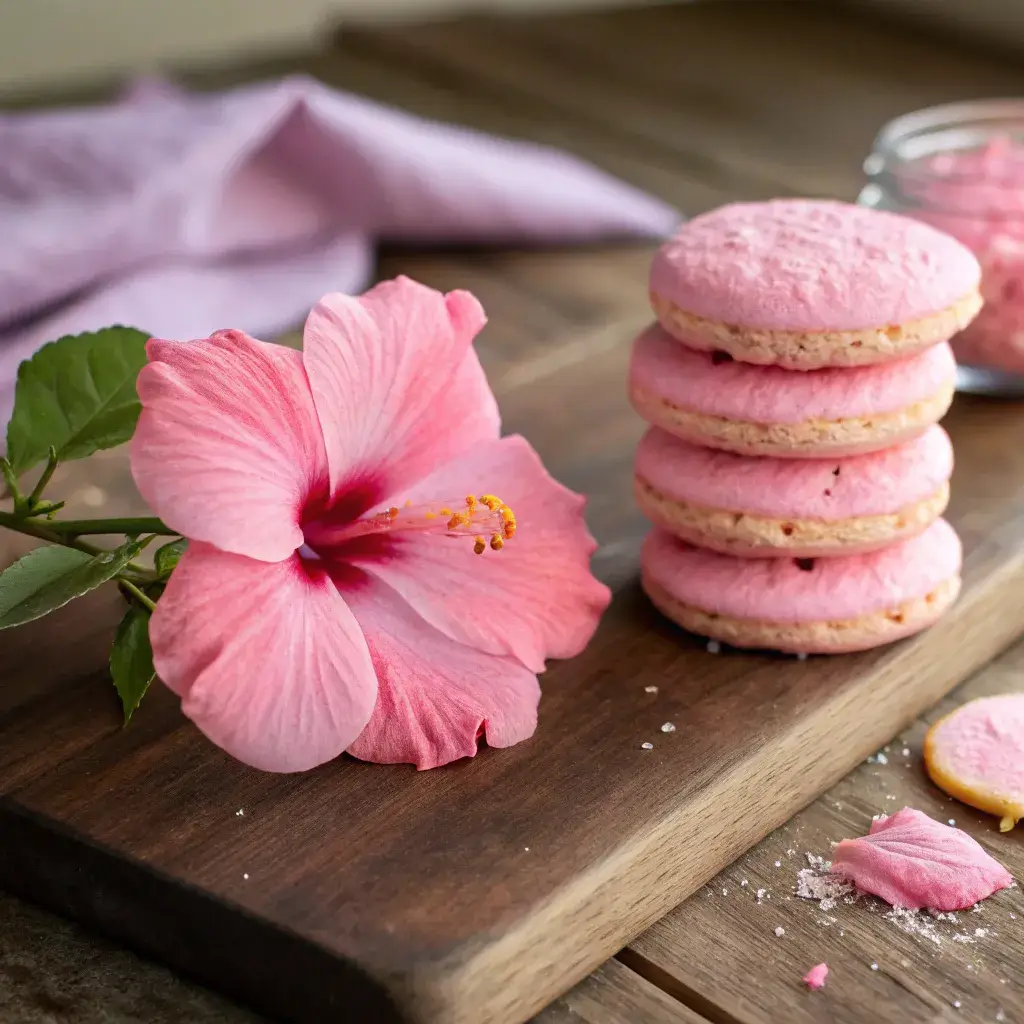
Spices and Herbs That Enhance Hibiscus Cookies
Subtle spices and herbs can bring out the best in hibiscus cookies. Vanilla and cinnamon add warmth, while cardamom and ginger introduce a gentle spiciness that complements hibiscus rather than overwhelming it. Fresh herbs like mint or basil can also be used sparingly for a refreshing twist.
Creative Hibiscus Pairings for Unique Cookie Recipes
For bakers who love to experiment, hibiscus pairs beautifully with coconut, almond, and honey. A coconut-hibiscus cookie has a tropical flair, while almond adds a nutty richness. Drizzling a light honey glaze over hibiscus cookies not only enhances the sweetness but also balances the tartness of hibiscus. These creative pairings ensure that hibiscus cookies are never boring and always impressive.
| Flavor Pairing | How It Enhances Hibiscus Cookies |
|---|---|
| Citrus fruits | Boosts brightness and tartness |
| Berries | Deepens fruity flavors |
| Cinnamon & ginger | Adds warmth and gentle spice |
| Coconut | Creates a tropical taste |
| Almond | Introduces nutty richness |
| Honey glaze | Balances tartness with natural sweetness |
Step-by-Step Hibiscus Cookie Recipe
Making hibiscus cookies at home is easier than you might think. Follow these clear, numbered steps to create a batch of colorful, flavorful cookies that everyone will love.
Ingredients You Will Need
For about 20 hibiscus cookies:
| Ingredient | Measurement |
|---|---|
| Gluten-free all-purpose flour | 2 cups |
| Dried hibiscus petals (ground) or hibiscus powder | 3 tbsp |
| Baking powder | 1 tsp |
| Salt | 1/4 tsp |
| Unsalted butter (softened) | 1/2 cup |
| Granulated sugar | 3/4 cup |
| Large egg | 1 |
| Pure vanilla extract | 1 tsp |
| Milk (or dairy-free alternative) | 2 tbsp |
| Optional: lemon or orange zest | 1 tsp |
Step-by-Step Instructions
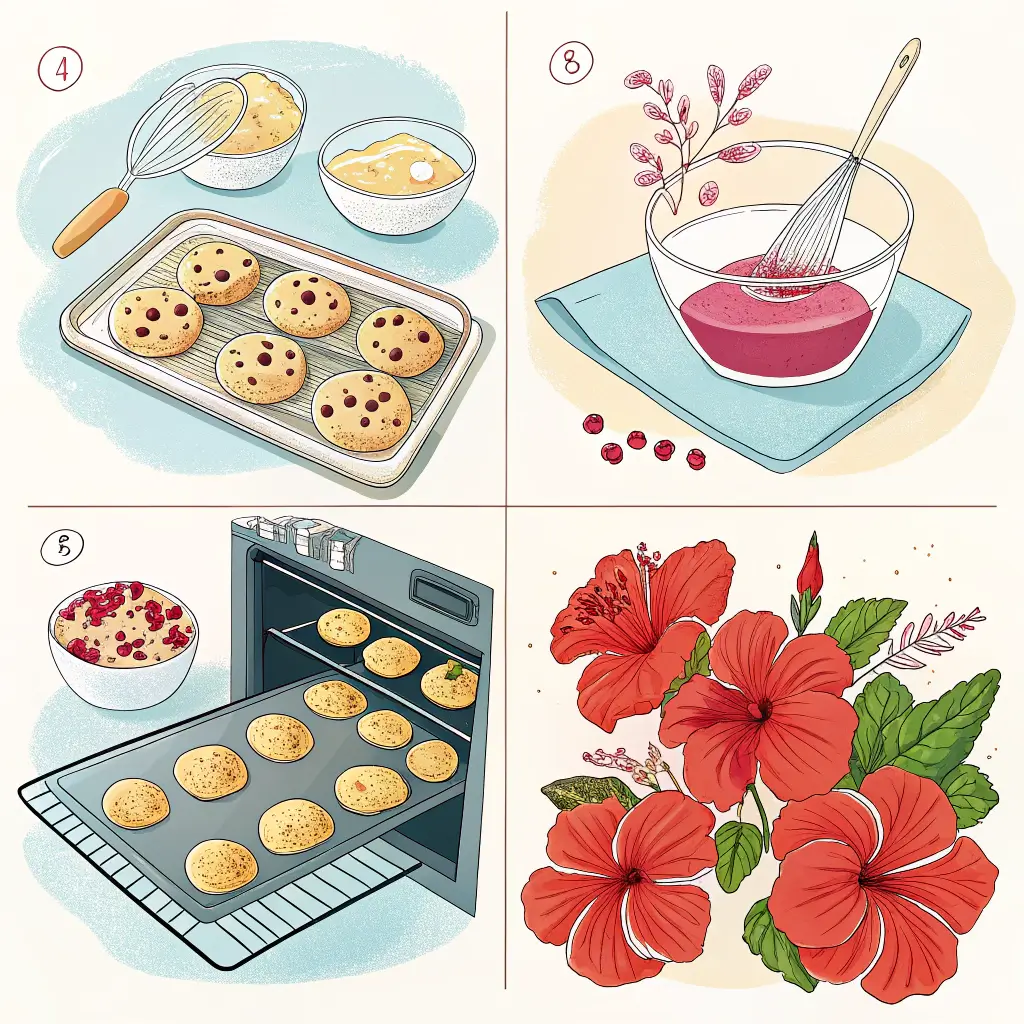
1. Preheat the Oven
Set your oven to 350°F (175°C). Line a baking sheet with parchment paper so your hibiscus cookies don’t stick.
2. Prepare the Hibiscus
If you are using dried hibiscus petals, grind them into a fine powder using a spice grinder or blender. Hibiscus powder gives your hibiscus cookies their signature bright pink color and tart flavor.
3. Mix the Dry Ingredients
In a medium bowl, whisk together:
- 2 cups gluten-free flour
- 3 tablespoons hibiscus powder
- 1 teaspoon baking powder
- 1/4 teaspoon salt
This ensures the hibiscus flavor is evenly distributed throughout your cookie dough.
4. Cream Butter and Sugar
In a large mixing bowl, beat together:
- 1/2 cup softened butter
- 3/4 cup granulated sugar
Mix until light and fluffy. Then add:
- 1 large egg
- 1 teaspoon vanilla extract
Beat again until smooth.
5. Combine Wet and Dry Mixtures
Add the dry ingredient mixture to the butter mixture in small increments, mixing on low speed until just incorporated. Stir gently, then add 2 tablespoons of milk. Mix until you have a smooth, soft dough. If you want extra brightness, add 1 teaspoon of lemon or orange zest.
6. Shape the Cookies
Scoop 1 tablespoon of dough at a time. Roll the dough into small balls and arrange them on the prepared baking sheet. Leave about 2 inches between each ball to allow the hibiscus cookies to spread while baking.
7. Bake
Place the tray in the preheated oven. Bake for 10–12 minutes, or until the edges are lightly golden while the centers remain soft. Avoid overbaking the cookies; they should stay slightly chewy.
8. Cool and Serve
Remove the cookies from the oven and allow them to cool on the baking sheet for 5 minutes. Then transfer to a wire rack. Once cooled, your hibiscus cookies are ready to serve and enjoy.
Baking Tips for Perfect Hibiscus Cookies
- For an extra vibrant color, steep a teaspoon of ground hibiscus in warm milk before mixing it into the dough.
- To prevent crumbling, do not skip the milk; it keeps hibiscus cookies soft and moist.
- Store cookies in an airtight container for up to 5 days, or freeze for extended freshness.
With this recipe, your hibiscus cookies will come out beautifully pink, slightly tart, and perfectly chewy, a treat that’s as stunning as it is delicious.
Variations of Hibiscus Cookies
Vegan Hibiscus Cookies
If you follow a plant-based lifestyle, you can still enjoy hibiscus cookies. Replace butter with coconut oil or vegan margarine, use flaxseed or chia seed gel as an egg substitute, and opt for almond or oat milk instead of dairy. The result is a colorful, plant-based treat that tastes just as delicious.
Gluten-Free Hibiscus Cookies
At Recipes of Kitchen, we always love gluten-free baking. For gluten-free hibiscus cookies, use a high-quality gluten-free all-purpose flour blend with xanthan gum included. This ensures the cookies hold their shape and texture while staying soft and chewy.
Hibiscus and Citrus Infused Cookies
For a bright burst of flavor, add fresh citrus zest to your hibiscus cookies. Lemon, lime, or orange zest enhances their natural tartness, making each bite even more refreshing. This hibiscus-and-citrus combo is especially popular for spring and summer gatherings.
Hibiscus Shortbread vs. Chewy Cookies
If you prefer crumbly cookies, make hibiscus shortbread by reducing the milk and increasing the butter. For chewy hibiscus cookies, stick with the standard recipe, and slightly underbake them to maintain a soft center.
| Variation | Key Adjustment | Result |
|---|---|---|
| Vegan | Coconut oil, flax egg | Dairy-free and plant-based |
| Gluten-Free | Gluten-free flour with xanthan | Soft, safe, and chewy |
| Citrus Infused | Add lemon or orange zest | Bright and refreshing |
| Hibiscus Shortbread | More butter, less milk | Crumbly and buttery |
| Chewy Hibiscus Cookies | Slightly underbake | Soft and chewy |
Storing and Serving Hibiscus Cookies
How to Store Hibiscus Cookies for Freshness
To keep your hibiscus cookies fresh, store them in an airtight container at room temperature for up to 5 days. If you need them to last longer, freeze them in a sealed freezer bag for up to 2 months. Always allow them to cool completely before storing to prevent moisture buildup.
Serving Suggestions for Tea Parties and Gatherings
Hibiscus cookies are perfect for tea parties, bridal showers, or holiday gatherings. Serve them alongside hibiscus tea or a light citrus punch for a coordinated flavor experience. They also make a stunning addition to a dessert platter, thanks to their rosy color.
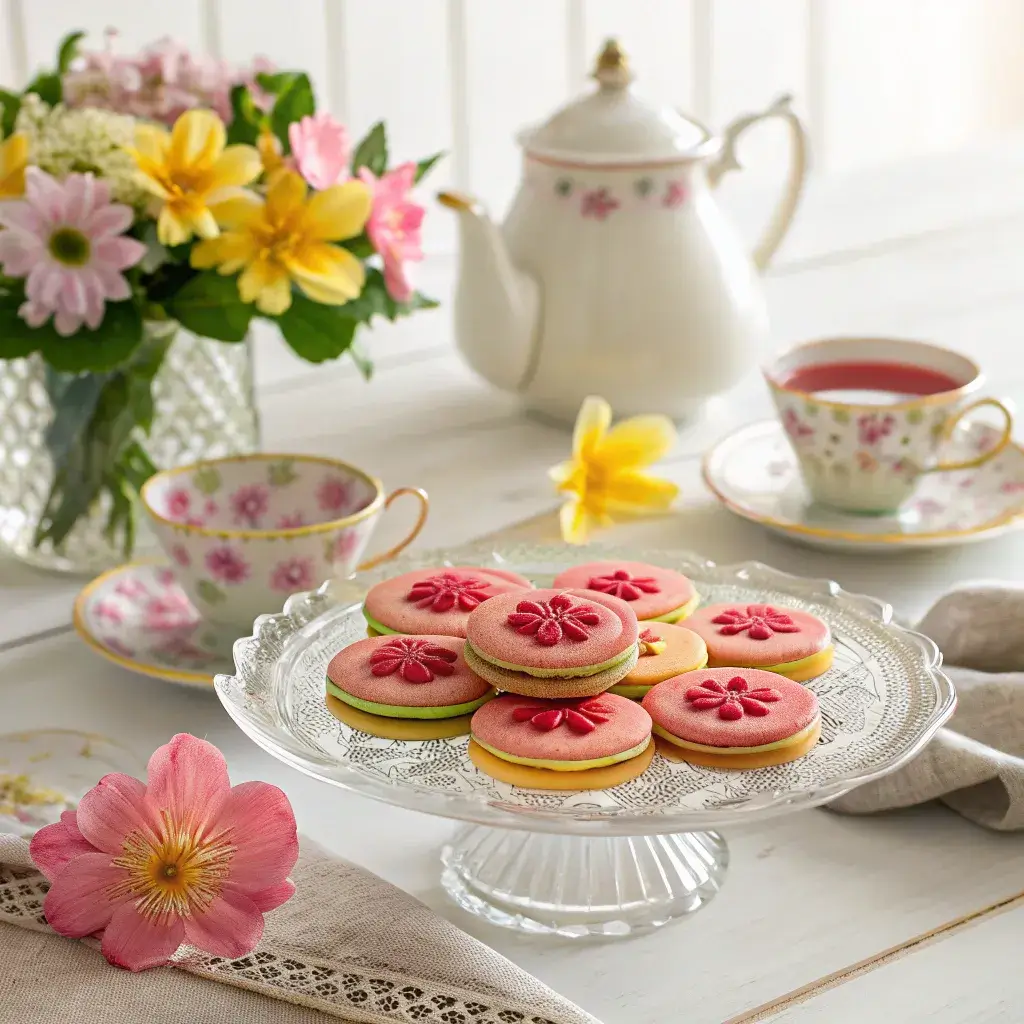
Packaging Hibiscus Cookies as Gifts
Homemade hibiscus cookies make thoughtful and eye-catching gifts. Place them in clear cellophane bags tied with a ribbon, or arrange them in a decorated tin. Adding a small tag with the recipe is a charming way to share the joy of baking.
| Storage Method | Shelf Life |
|---|---|
| Airtight container | Up to 5 days |
| Refrigerated | Up to 10 days |
| Frozen (airtight bag) | Up to 2 months |
Frequently Asked Questions About Hibiscus Cookies
What not to mix with hibiscus?
When baking hibiscus cookies, avoid pairing hibiscus with strong flavors like peppermint, dark chocolate, or coffee, as these can overpower its tart, floral notes. Stick with lighter companions such as citrus, vanilla, or mild spices.
What is the flavor of hibiscus?
Hibiscus has a tart, fruity, and slightly floral flavor often compared to cranberry or pomegranate. This makes hibiscus cookies refreshing and different from traditional cookie flavors.
Is hibiscus the same as jamaica flour?
Not exactly. Hibiscus and Jamaica both refer to the dried flower of Hibiscus sabdariffa, but Jamaica is a common name used in Latin America, especially for hibiscus tea. Jamaica is not a flour but can be ground into a powder for use in hibiscus cookies.
What flavors pair with hibiscus?
Hibiscus pairs beautifully with citrus fruits like lemon and orange, as well as berries, vanilla, cinnamon, and honey. These ingredients enhance the tartness and floral quality of hibiscus cookies without masking their natural taste.
Conclusion
Hibiscus cookies are more than just a treat; they are a beautiful way to bring color, flavor, and creativity into gluten-free baking. With their tart, fruity taste and stunning natural pink hue, these cookies are perfect for tea parties, gifts, or simply enjoying at home. By learning what flavors pair best, how to balance hibiscus correctly, and trying different variations, you’ll be able to bake hibiscus cookies that are just as delightful to look at as they are to eat.

